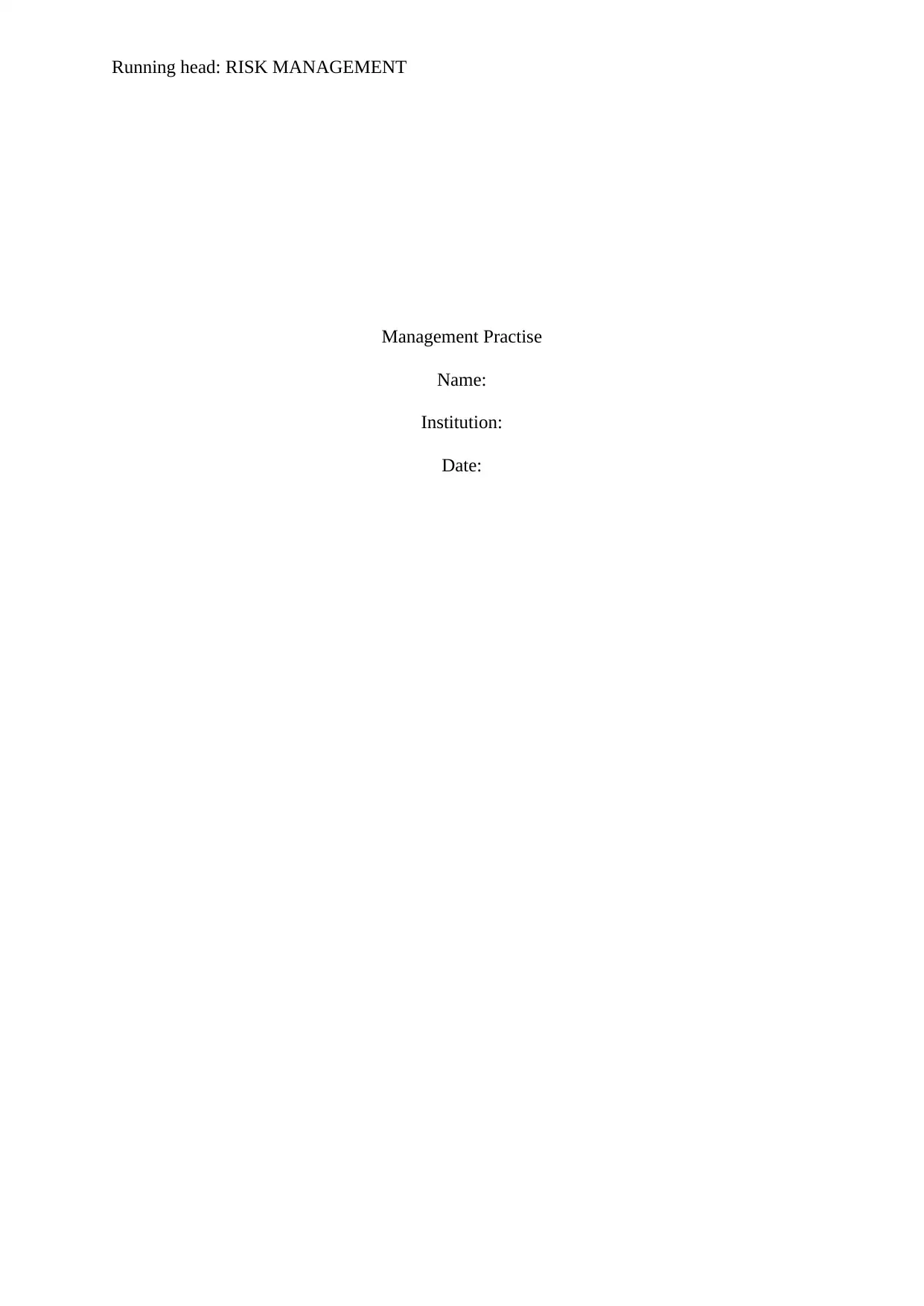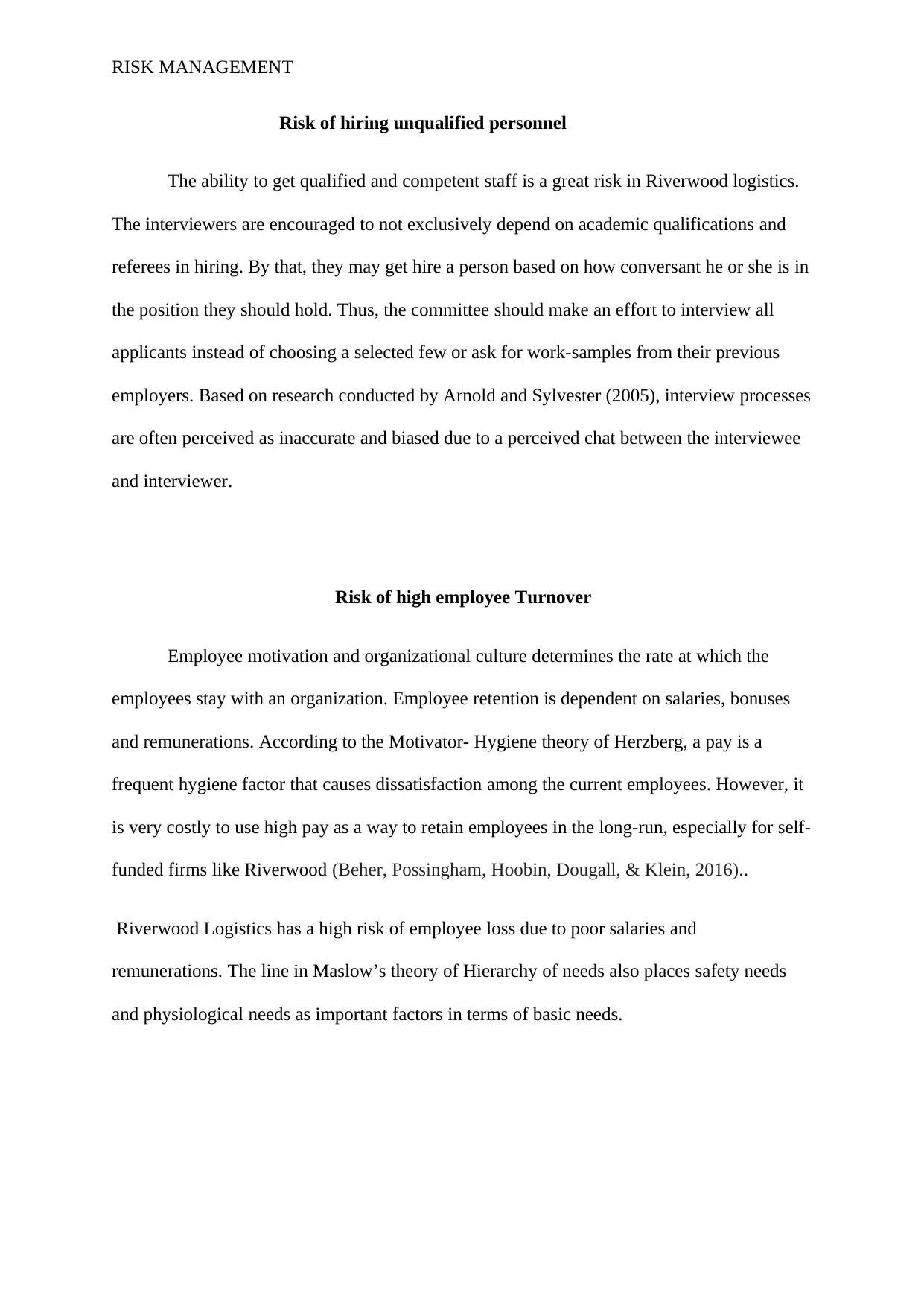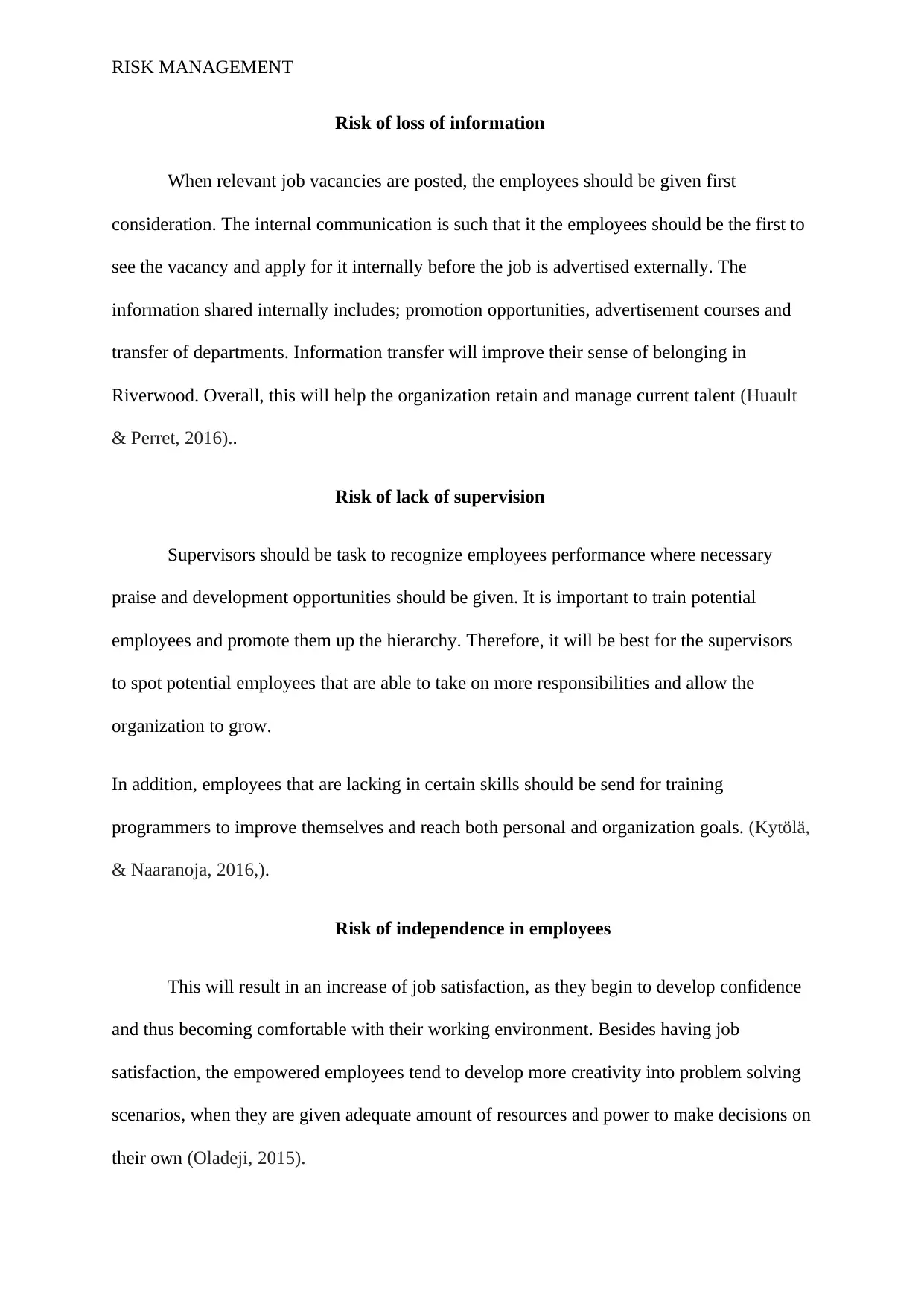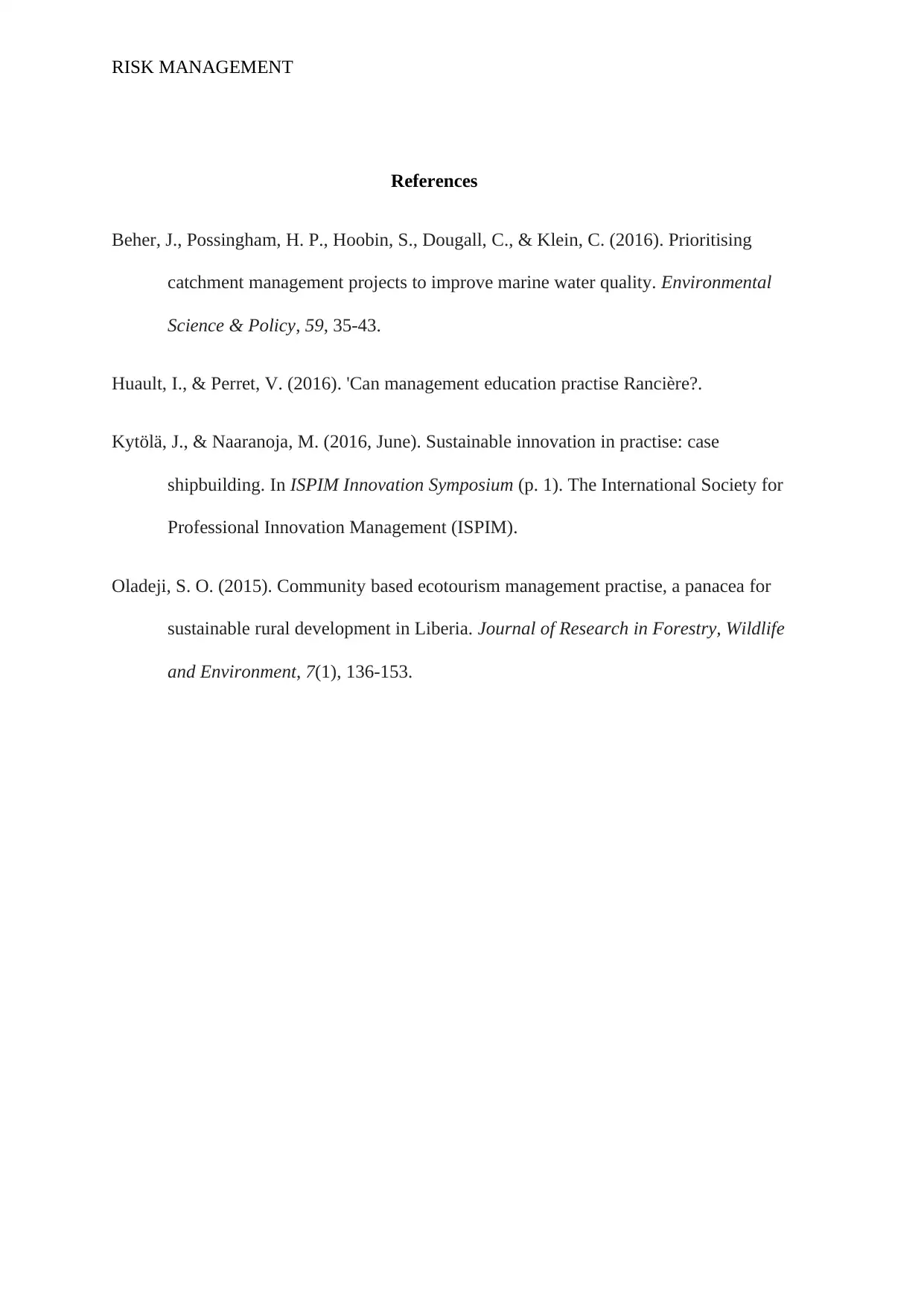Risk Management in Hiring, Employee Turnover, Information Loss, Supervision, and Independence
VerifiedAdded on 2023/06/05
|4
|695
|392
AI Summary
This article discusses the risks associated with hiring unqualified personnel, high employee turnover, loss of information, lack of supervision, and independence in employees. It also provides recommendations on how to manage these risks.
Contribute Materials
Your contribution can guide someone’s learning journey. Share your
documents today.

Running head: RISK MANAGEMENT
Management Practise
Name:
Institution:
Date:
Management Practise
Name:
Institution:
Date:
Secure Best Marks with AI Grader
Need help grading? Try our AI Grader for instant feedback on your assignments.

RISK MANAGEMENT
Risk of hiring unqualified personnel
The ability to get qualified and competent staff is a great risk in Riverwood logistics.
The interviewers are encouraged to not exclusively depend on academic qualifications and
referees in hiring. By that, they may get hire a person based on how conversant he or she is in
the position they should hold. Thus, the committee should make an effort to interview all
applicants instead of choosing a selected few or ask for work-samples from their previous
employers. Based on research conducted by Arnold and Sylvester (2005), interview processes
are often perceived as inaccurate and biased due to a perceived chat between the interviewee
and interviewer.
Risk of high employee Turnover
Employee motivation and organizational culture determines the rate at which the
employees stay with an organization. Employee retention is dependent on salaries, bonuses
and remunerations. According to the Motivator- Hygiene theory of Herzberg, a pay is a
frequent hygiene factor that causes dissatisfaction among the current employees. However, it
is very costly to use high pay as a way to retain employees in the long-run, especially for self-
funded firms like Riverwood (Beher, Possingham, Hoobin, Dougall, & Klein, 2016)..
Riverwood Logistics has a high risk of employee loss due to poor salaries and
remunerations. The line in Maslow’s theory of Hierarchy of needs also places safety needs
and physiological needs as important factors in terms of basic needs.
Risk of hiring unqualified personnel
The ability to get qualified and competent staff is a great risk in Riverwood logistics.
The interviewers are encouraged to not exclusively depend on academic qualifications and
referees in hiring. By that, they may get hire a person based on how conversant he or she is in
the position they should hold. Thus, the committee should make an effort to interview all
applicants instead of choosing a selected few or ask for work-samples from their previous
employers. Based on research conducted by Arnold and Sylvester (2005), interview processes
are often perceived as inaccurate and biased due to a perceived chat between the interviewee
and interviewer.
Risk of high employee Turnover
Employee motivation and organizational culture determines the rate at which the
employees stay with an organization. Employee retention is dependent on salaries, bonuses
and remunerations. According to the Motivator- Hygiene theory of Herzberg, a pay is a
frequent hygiene factor that causes dissatisfaction among the current employees. However, it
is very costly to use high pay as a way to retain employees in the long-run, especially for self-
funded firms like Riverwood (Beher, Possingham, Hoobin, Dougall, & Klein, 2016)..
Riverwood Logistics has a high risk of employee loss due to poor salaries and
remunerations. The line in Maslow’s theory of Hierarchy of needs also places safety needs
and physiological needs as important factors in terms of basic needs.

RISK MANAGEMENT
Risk of loss of information
When relevant job vacancies are posted, the employees should be given first
consideration. The internal communication is such that it the employees should be the first to
see the vacancy and apply for it internally before the job is advertised externally. The
information shared internally includes; promotion opportunities, advertisement courses and
transfer of departments. Information transfer will improve their sense of belonging in
Riverwood. Overall, this will help the organization retain and manage current talent (Huault
& Perret, 2016)..
Risk of lack of supervision
Supervisors should be task to recognize employees performance where necessary
praise and development opportunities should be given. It is important to train potential
employees and promote them up the hierarchy. Therefore, it will be best for the supervisors
to spot potential employees that are able to take on more responsibilities and allow the
organization to grow.
In addition, employees that are lacking in certain skills should be send for training
programmers to improve themselves and reach both personal and organization goals. (Kytölä,
& Naaranoja, 2016,).
Risk of independence in employees
This will result in an increase of job satisfaction, as they begin to develop confidence
and thus becoming comfortable with their working environment. Besides having job
satisfaction, the empowered employees tend to develop more creativity into problem solving
scenarios, when they are given adequate amount of resources and power to make decisions on
their own (Oladeji, 2015).
Risk of loss of information
When relevant job vacancies are posted, the employees should be given first
consideration. The internal communication is such that it the employees should be the first to
see the vacancy and apply for it internally before the job is advertised externally. The
information shared internally includes; promotion opportunities, advertisement courses and
transfer of departments. Information transfer will improve their sense of belonging in
Riverwood. Overall, this will help the organization retain and manage current talent (Huault
& Perret, 2016)..
Risk of lack of supervision
Supervisors should be task to recognize employees performance where necessary
praise and development opportunities should be given. It is important to train potential
employees and promote them up the hierarchy. Therefore, it will be best for the supervisors
to spot potential employees that are able to take on more responsibilities and allow the
organization to grow.
In addition, employees that are lacking in certain skills should be send for training
programmers to improve themselves and reach both personal and organization goals. (Kytölä,
& Naaranoja, 2016,).
Risk of independence in employees
This will result in an increase of job satisfaction, as they begin to develop confidence
and thus becoming comfortable with their working environment. Besides having job
satisfaction, the empowered employees tend to develop more creativity into problem solving
scenarios, when they are given adequate amount of resources and power to make decisions on
their own (Oladeji, 2015).

RISK MANAGEMENT
References
Beher, J., Possingham, H. P., Hoobin, S., Dougall, C., & Klein, C. (2016). Prioritising
catchment management projects to improve marine water quality. Environmental
Science & Policy, 59, 35-43.
Huault, I., & Perret, V. (2016). 'Can management education practise Rancière?.
Kytölä, J., & Naaranoja, M. (2016, June). Sustainable innovation in practise: case
shipbuilding. In ISPIM Innovation Symposium (p. 1). The International Society for
Professional Innovation Management (ISPIM).
Oladeji, S. O. (2015). Community based ecotourism management practise, a panacea for
sustainable rural development in Liberia. Journal of Research in Forestry, Wildlife
and Environment, 7(1), 136-153.
References
Beher, J., Possingham, H. P., Hoobin, S., Dougall, C., & Klein, C. (2016). Prioritising
catchment management projects to improve marine water quality. Environmental
Science & Policy, 59, 35-43.
Huault, I., & Perret, V. (2016). 'Can management education practise Rancière?.
Kytölä, J., & Naaranoja, M. (2016, June). Sustainable innovation in practise: case
shipbuilding. In ISPIM Innovation Symposium (p. 1). The International Society for
Professional Innovation Management (ISPIM).
Oladeji, S. O. (2015). Community based ecotourism management practise, a panacea for
sustainable rural development in Liberia. Journal of Research in Forestry, Wildlife
and Environment, 7(1), 136-153.
1 out of 4
Your All-in-One AI-Powered Toolkit for Academic Success.
+13062052269
info@desklib.com
Available 24*7 on WhatsApp / Email
![[object Object]](/_next/static/media/star-bottom.7253800d.svg)
Unlock your academic potential
© 2024 | Zucol Services PVT LTD | All rights reserved.